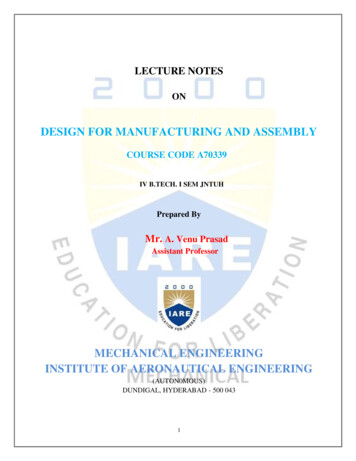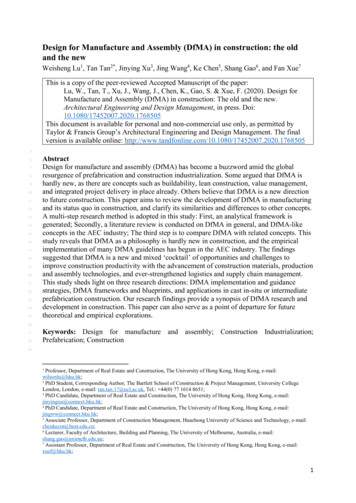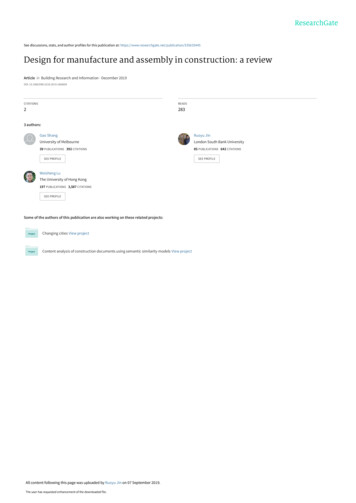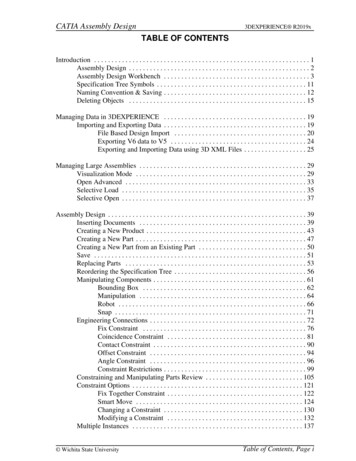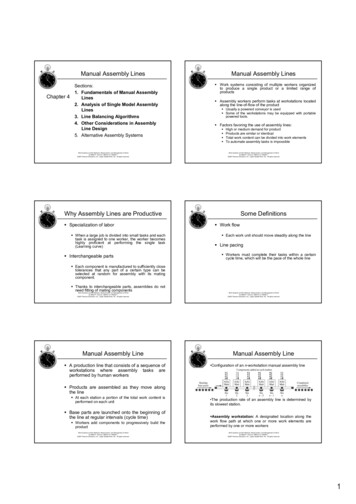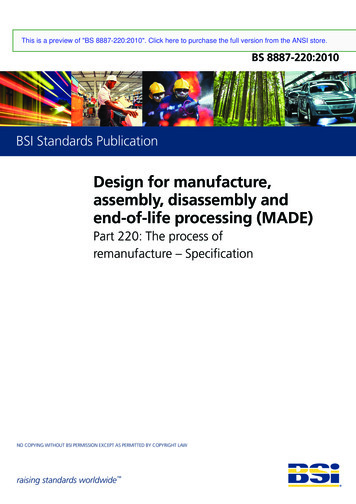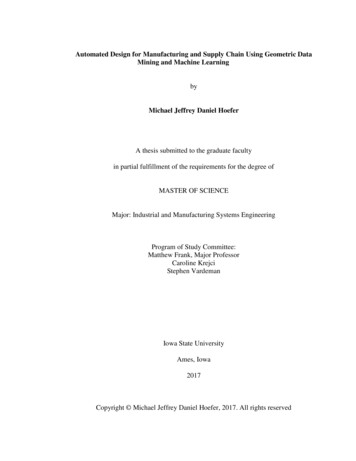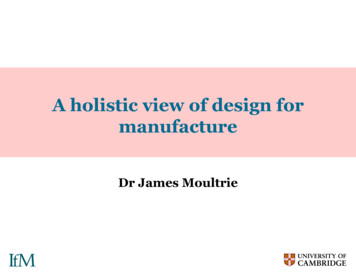
Transcription
White PaperDesign for Manufactureand Assembly: Time to Save
Design to Manufacture01Contents1.0 Simplify the process021.1 Understanding DFM&A041.2 The benefits and dangers of DFM&A052.0 An improved end product1.0 Simplify the ProcessCountless products enterIn most cases, producers failthe marketplace every year.to move from conception toHowever, many do not turn aproduction in a timely mannerprofit. In fact, three-quartersdue to slow-moving strategicof all consumer products failplanning activities or relianceto reach the first-year saleson external manufacturersthreshold of 7.5 million andthat maintain antiquated ora mere 3 percent succeed insegmented design, fabricationpulling in 50 million duringand assembly processes.their first 12 months on shelves– the figure industry expertsIndividuals and businessescite as the standard for acan avoid such a situation“highly successful” debut.1and increase their chances ofreleasing successful productsWhile a variety of internalby partnering with productmissteps can lay thedevelopment firms that embracegroundwork for failure, therethe design for manufacture andis one error that often provesassembly methodology. Thismost fatal to companiesproven approach facilitates theand entrepreneurs withcreation of quality productspotentially transformativewhile reducing time-to-marketproducts: getting mired inand keeping overhead costs low.product development limbo.Design for Manufacture and Assembly: Time to Save“Why Most Product Launches Fail,” HarvardBusiness Review, 2011.101
Design to Manufacture1.1 Understanding DFM&AEngineering faculty at theUniversity of Massachusetts areManufacturers fleshed out DFM&A in the yearscredited with establishing thecore concepts of DFM&A, whichfollowing its creation at UMass, creating multipleis said to have grown out of auniversal guidelines for properly deploying theNational Science Foundation-methodology, including:funded research projectDesigning for as few parts as possible.conducted at the college in 1977.2The methodology combines twoAdopting modular design principles.existing fabrication strategies– design for manufactureMinimizing fastener usage.and design for assembly –Reducing post-assembly adjustment.into one integrated productdevelopment model designedSupporting production variation.to produce goods that containfew parts (DFA) and are easy tomanufacture en masse (DFM).2“DFMA and Its Roles in the Integrated Product Development Process,” Massachusetts Institute of Technology, 1996.Design for Manufacture and Assembly: Time to Save02
Design to ManufactureBy the 1980s, producers acrossToday, organizationsIndustrial manufacturers are,multiple sectors had embracedeverywhere are leveragingof course, doing the same,DFM&A – most notably,DFM&A in their operations andintegrating DFM&A processesautomotive manufacturer Ford,finding success. For example,into existing lean workflowswhich oversaw one of the firstthe Royal Institute of Britishand achieving great success forgreat product release successesArchitects promotes thethemselves and their clients.5attributed to the strategy.3 Theapproach in the construction3company debuted the DFM&A-space, where builders are4produced Taurus in 1985, ausing prefabrication processesvehicle that not only sold well butto assemble 80 percent ofsaved Ford billions in overhead.structural components offsite.4Design for Manufacture and Assembly: Time to Save“DFMA Cuts Billions in Manufacturing Costs,”Design News, 2016.“RIBA Plan of Work 2013: Design ForManufacturing and Assembly,” Royal Institute ofBritish Architects, 2013.2“DFMA – A Potent Lean Methodology,” AssemblyMagazine, 2013.03
Design to Manufacture1.2 The Benefits and Dangers of DFM&Asimpler products while includingvariability in the equation,expenses drop dramatically.While potentiallytransformative, the DFM&Amethodology comes with somepitfalls – namely, extended leadtimes and increased toolingcosts. These outcomes oftenunfold due to sales forecastingerrors and overdesign. Withthese undesirable scenariosin mind, engineers shouldcollaborate with clients’engineering, marketingand sales teams to developquality products that notonly pass muster but also setbusinesses up for success inthe marketplace. Through thiscollaborative process, clientsget the most out of DFM&AOrganizations that adoptAdditionally, because DFM&ADFM&A or collaborate withemphasizes holistic productexternal manufacturers thatdevelopment, many businessesuse the strategy tend to seesee cost savings as a resultsignificant results. Producersof more in-depth product5have been known to cutplanning processes. During the6required parts inventories indesign phase, 60 percent to 80half, a material savings thatpercent of the fixed productionresults in sturdier, easier-to-costs associated with a givenreplicate products that cost lessproduct are determined. Whenand hit the market quicker.businesses can carefully plan outDesign for Manufacture and Assembly: Time to Savewithout running into theroadblocks that can come withover–reliance on the strategy.“Measuring DFMA Savings,” AutomationWorld, 2008.“Measuring DFMA Savings,” AutomationWorld, 2008.7“DFMA and Its Roles in the IntegratedProduct Development Process,”Massachusetts Institute of Technology, 1996.04
Design to Manufacture2.0 An Improved End ProductCompanies or entrepreneurstrends, these companies mustsearching for success cannotembrace accelerated workflowsafford to pin their ambitionsthat reduce the expense ofto antiquated and fracturedchurning out physical offeringsdevelopment and testingand ensure items hit the shelvesprocesses that drive upat the height of demand.overhead costs, increase timeto-market and result in lessBy taking a more balancedprofitable products. In today’sapproach to using DFM&A,marketplace, an arena ruledengineers and their clients willby ever-changing consumerboth be rewarded.Design for Manufacture and Assembly: Time to SaveConnect withus today to learnmore about ourunique approachto DFM&A05
Design to Manufacturewww.datum3d.com(617) 926-7400108 Water St. Suite #1Watertown, MA 02472
the design for manufacture and assembly methodology. This proven approach facilitates the creation of quality products while reducing time-to-market and keeping overhead costs low. Design for Manufacture and Assembly: Time to Save 01 1“Why Most Produc
